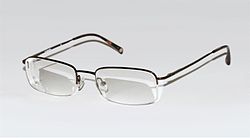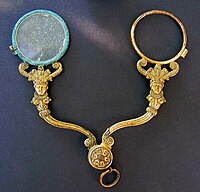This is an old revision of this page, as edited by 205.126.74.179 (talk) at 19:56, 12 November 2008 (→Types). The present address (URL) is a permanent link to this revision, which may differ significantly from the current revision.
Revision as of 19:56, 12 November 2008 by 205.126.74.179 (talk) (→Types)(diff) ← Previous revision | Latest revision (diff) | Newer revision → (diff) "Glasses" can also be the plural of "glass". "Spectacles" redirects here. For other uses, see Spectacle (disambiguation).
Glasses, also called eyeglasses or spectacles, are frames bearing lenses worn in front of the eyes, normally for vision correction, eye protection, or for protection from UV rays.
Modern glasses are typically supported by pads on the bridge of the nose and by temples placed over the ears. Historical types include the pince-nez, monocle, and lorgnette.
Eyeglass frames are commonly made from metal or plastic. Lenses were originally made from glass, but many are now made from various types of metal plastic, including CR-39 and polycarbonate. These materials reduce the danger of breakage and weigh less than glass lenses. Some plastics also have more advantageous optical properties than glass, such as better transmission of visible light and greater absorption of ultraviolet light. Some plastics have a greater index of refraction than most types of glass; this is useful in the making of corrective lenses shaped to correct various vision abnormalities such as myopia, allowing thinner lenses for a given prescription. Newer plastic lenses, called izon, can also correct for the higher order aberrations that naturally occur in the surface of our eye. These lenses create sharper vision and help with the halos, starbursts, and comet-tails often associated with night time driving glare. Wavefront guided LASIK surgery also corrects for the higher order aberrations.

Scratch-resistant coatings can be applied to most plastic lenses giving them similar scratch resistance to glass. Hydrophobic coatings designed to ease cleaning are also available, as are anti-reflective coatings intended to reduce glare, improve night vision and make the wearer's eyes more visible.
CR-39 lenses are the most common plastic lenses due to their low weight, high scratch resistance, and low transparency for ultra violet and infrared radiation. Polycarbonate and Trivex lenses are the lightest and most shatter-resistant, making them the best for impact protection, yet offer poor optics due to high dispersion, and having a low Abbe number of 31.
Not all glasses are designed solely for vision correction but are worn for protection, viewing visual information (such as stereoscopy) or simply just for aesthetic or fashion values. Safety glasses are a kind of eye protection against flying debris or against visible and near visible light or radiation. Sunglasses allow better vision in bright daylight, and may protect against damage from high levels of ultraviolet light.
Variations
Magnifying lenses which are used to treat mild hyperopia and presbyopia, normally referred to as reading glasses, can be bought off the shelf. Most glasses are made to an individual prescription, based on degree of myopia or hyperopia combined with astigmatism if applicable. Lenses can be ground to specific prescriptions, but in some cases standard off-the-shelf prescriptions suffice, though they require custom fitting to particular frames.
As people age, their ability to focus is lessened and many decide to use multiple-focus lenses, bifocal or even trifocal to cover all the situations in which they use their sight. Traditional multifocal lenses have two or three distinct horizontal viewing areas, each requiring a conscious effort of refocusing. Some modern multifocal lenses, such as Progressive lenses (known as "no-line bifocals"), give a smooth transition between these different focal points, unnoticeable by most wearers, while other glasses have lenses specifically intended for use with computer monitors at a fixed distance. People may have several pairs of glasses, one for each task or distance, with specific glasses for reading, computer use, television watching, and writing.
Rimless
Three-piece rimless and semi-rimless glasses are common variations that differ from regular glasses in that their frames do not completely encircle the lenses. Three-piece rimless glasses have no frame around the lenses, and the bridge and temples are mounted directly onto the lenses. Semi-rimless (or half-rimless) glasses have a frame that only partially encircles the lenses (commonly the top portion), which are held in place most often by high strength nylon wire. A rare and currently non commercial variation are rimless and frameless glasses attached to a piercing at the bridge of a wearers nose. Such glasses have the visual look of the pince-nez.
Glazing
Spectacle lenses are edged into the frame's rim using glazing machines operated by ophthalmic technicians. The edging process begins with a trace being taken of the frame's eye shape. In earlier days the trace was replicated onto a plastic pattern called a Former. Nowadays the process is patternless and the shape is sent to the edger electronically.
The lens, in the form of a round uncut, is positioned in the correct manner to match the prescription and a block is stuck to the lens and that block fits into a chuck in the edging machine. A diamond coated wheel spins as the edger replicates the frame's eye-shape to the uncut lens. A 'v' bevel is applied to allow the edge of the lens to fit into the frame rim.
Fashion

Glasses can be a major part of personal expression, from the extravagance of Elton John and Dame Edna Everage, to Groucho Marx and Buddy Holly.
For some celebrities, glasses form part of their identity. United States Senator Barry Goldwater continued to wear lensless horn-rimmed spectacles after being fitted with contact lenses because he was not recognizable without his trademark glasses. British soap star Anne Kirkbride had the same problem: her character on Coronation Street, Deirdre Barlow, became so well-known for her big frames that she was expected to wear them at social gatherings and in international tours, even though Kirkbride has always worn contact lenses. Drew Carey continued to wear glasses for the same reason after getting corrective laser eye surgery. British comedic actor Eric Sykes, who became profoundly deaf as an adult, wears glasses that contain no lenses; they are actually a bone-conducting hearing aid. Masaharu Morimoto wears glasses to separate his professional persona as a chef from his stage persona as Iron Chef Japanese. John Lennon wore his round-lens 'Windsor' spectacles from some of his time with the Beatles to his murder in 1980. The rock band Weezer is known for some of the members wearing thick-rimmed glasses.
In popular culture, glasses were all the disguise Superman and Wonder Woman needed to hide in plain view as alter egos Clark Kent and Diana Prince, respectively. An example of halo effect is seen in the stereotype that those who wear glasses are intelligent or, especially in teen culture, even geeks and nerds. Some people who find that wearing glasses may look nerdy turn to contact lenses or laser eye surgery, especially under peer pressure.
Another unpopular aspect of glasses is their inconvenience. Even through the creation of light frames, such as those made of titanium, very flexible frames, and new lens materials and optical coatings, glasses can still cause problems during rigorous sports. The lenses can become greasy or trap vapour when eating hot food, swimming, walking in rain or rapid temperature changes (such as walking into a warm building from cold temperatures outside), reducing visibility significantly. Scraping, fracturing, or breakage of the lenses require time-consuming and costly professional repair, though modern plastic lenses are almost indestructible and very scratch-resistant.
Apple, Inc. co-founder Steve Wozniak had a pair of eyeglasses made with lenses in the shape of the well-known Apple logo. The lenses were made from a block of acrylic, laminated from layers in the usual rainbow colors, and machined into the appropriate outline, with a custom-made frame in the same shape. They were made by a Silicon Valley optician.
Disposal
Some organizations like Lions Clubs International and Unite For Sight provide a way to donate glasses and sunglasses. Unite For Sight has redistributed more than 200,000 pairs.
See also
- Eye examination
- Eyeglass prescription
- Corrective lens
- Geek chic
- History of optics
- Meganekko
- X-ray vision
- Stereoscopy
References
- ^ DeFranco, Liz (2007). "Polycarbonate Lenses: Tough as Nails". All About Vision. Retrieved 2007-09-01.
{{cite web}}: Unknown parameter|month=ignored (help) - DeFranco, Liz (2006). "Do You Need Lens Coatings?". All About Vision. Retrieved 2007-09-01.
{{cite web}}: Unknown parameter|month=ignored (help) - O’Keefe, Jackie (July/August 2003). "The Newest Technologies in Rimless Eyewear". Vision Care Product News. Retrieved 2006-01-09.
{{cite web}}: Check date values in:|date=(help); Italic or bold markup not allowed in:|publisher=(help) - "Pierced Glasses". Retrieved 2007-08-07.
- Lions Clubs International. "Lions Eyeglasses Recycling Facts " received 20 August 2008.
- Unite For Sight "Donate Eyeglasses and Sunglasses" received on 20 August 2008.
- "2007 BRICK Award Winner: Jennifer Staple" HowStuffWorks 20 February 2007, received 20 August 2008.
External links
Listen to this article(2 parts, 25 minutes)
- Antique Spectacles, extensive history and pictures of spectacles.
- British Optical Association Museum, Spectacles Gallery
- History of Eye Glasses, Teagle Optometry